For generations, the story of American pizza history has prominently featured Lombardi’s Pizza at its Spring Street location in New York City. Often touted as the first pizzeria in the United States, established in 1905 by Gennaro Lombardi, this narrative, while romantic, doesn’t entirely align with historical evidence. While Lombardi’s Pizza on Spring Street is undoubtedly a landmark in the American pizza landscape, a closer look at historical records reveals a more nuanced and fascinating origin story. This article delves into the documented history of 53 Spring Street, the original location of what is now known as Lombardi’s Pizza (currently located at 32 Spring St.), to uncover the truth behind its early days and the individuals who shaped its legacy, revealing a history richer and more complex than the commonly accepted myth.
Unearthing the Past: New York City Directories and Early Occupants of 53 Spring Street
To accurately trace the history of 53 Spring Street, early 20th-century New York City directories serve as invaluable primary sources. These directories, meticulously documenting residents and businesses, provide a chronological snapshot of who operated at this address. Examining these records for “53 Spring St.” or “53 1/2 Spring St.” (addresses used interchangeably for the location) paints a compelling picture, challenging the long-held belief that Gennaro Lombardi was the founder in 1905.
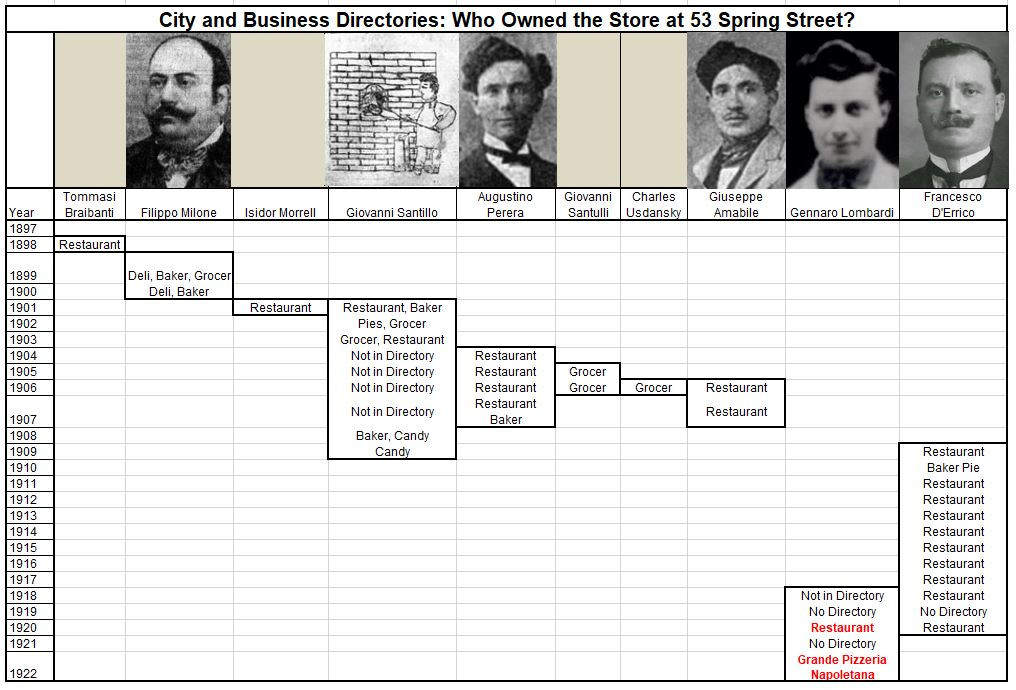 A table extracted from New York City directories listing owners and their occupations at 53 Spring Street, highlighting the absence of Gennaro Lombardi until 1920, contradicting claims of his 1905 establishment.
A table extracted from New York City directories listing owners and their occupations at 53 Spring Street, highlighting the absence of Gennaro Lombardi until 1920, contradicting claims of his 1905 establishment.
The directory evidence clearly indicates that Gennaro Lombardi’s name doesn’t appear in connection with 53 Spring Street until 1920. Prior to this, the directories list a succession of owners and business descriptions, none of which initially include “pizzeria.” While directories offer crucial name and address information, their business descriptions can be somewhat ambiguous. For instance, Filippo Milone, an early occupant, is described at different times as a grocer, delicatessen owner, and baker – all seemingly referring to the same establishment around 1899. Intriguingly, the term “pizzeria” doesn’t surface in directory descriptions for 53 Spring Street until 1922. This necessitates further investigation beyond directories to pinpoint when pizza became the specialty of this Spring Street establishment.
Newspaper Advertisements: Italian-American Voices and the Emergence of Pizza at Spring Street
To gain a more detailed understanding of the culinary offerings at 53 Spring Street, we turn to Italian-American newspapers of the era. These publications provide a richer context, revealing advertisements and announcements that offer insights into the types of businesses operating in the Italian-American community.
Initially, research points to Tommasi Braibanti as the operator of the establishment at 53 Spring Street, likely from the summer of 1897 to 1898. However, an advertisement from August 1897 in L’Araldo Italiano suggests Braibanti ran a pastry shop, not a pizzeria, indicating pizza was likely not yet the focus at this location.
 An advertisement from the Italian-American newspaper L'Araldo Italiano in August 1897, showcasing Tommasi Braibanti's pastry shop at 53 Spring Street, suggesting pizza was not yet the primary offering.
An advertisement from the Italian-American newspaper L'Araldo Italiano in August 1897, showcasing Tommasi Braibanti's pastry shop at 53 Spring Street, suggesting pizza was not yet the primary offering.
Following Braibanti, Filippo Milone took over in the summer of 1898. While a direct advertisement from Milone during his time at 53 Spring Street (1898-1900) remains undiscovered, his subsequent career strongly suggests he was indeed running a pizzeria. Shortly after leaving Spring Street, Milone opened pizzerias at 130 W. 26th St. in 1901 and 192 Grand St in 1903, both documented with advertisements explicitly promoting pizza. Considering Milone’s consistent focus on pizza throughout his career, it’s highly probable that when directories list him as a “baker” at 53 Spring Street, he was, in fact, baking and selling pizza, making him a strong candidate for establishing the pizzeria there between 1898 and 1900.
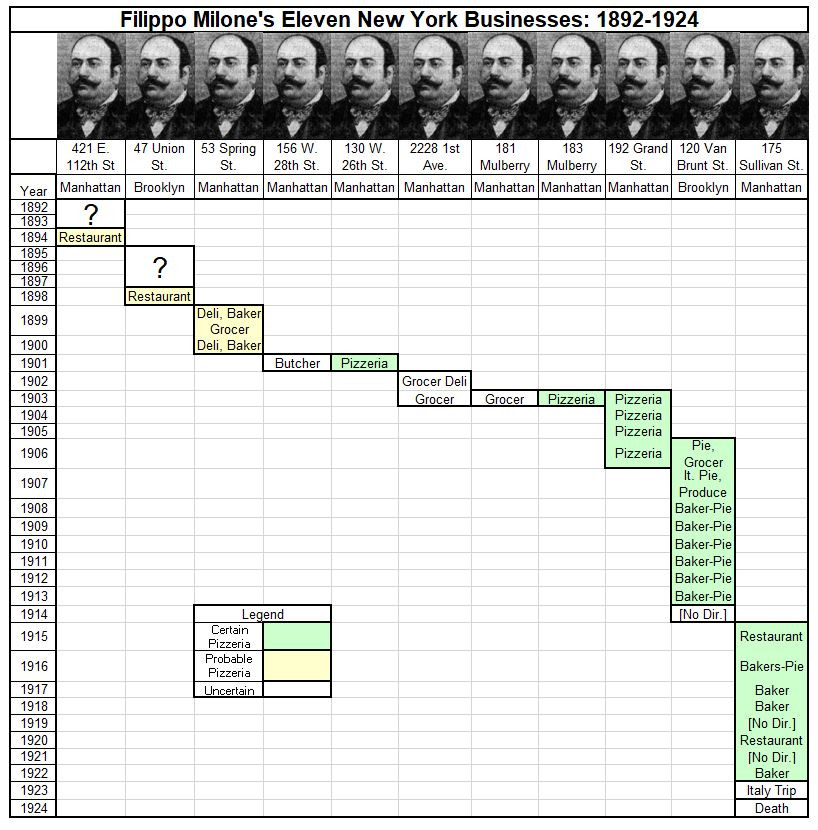 A compilation of advertisements from Filippo Milone's career, highlighting his consistent association with pizzerias and pizza making, strengthening the likelihood he introduced pizza to 53 Spring Street.
A compilation of advertisements from Filippo Milone's career, highlighting his consistent association with pizzerias and pizza making, strengthening the likelihood he introduced pizza to 53 Spring Street.
Further solidifying the pizzeria’s presence is the 1902 Trow’s Business Directory listing for Giovanni Santillo, Milone’s successor. Santillo is categorized under “Bakers, Pie,” a strong indication that the “pie” referred to was pizza, particularly given Santillo’s later explicit advertisements as a pizzeria owner. By August 1904, newspaper advertisements definitively confirm Giovanni Santillo operating “Antica Pizzeria Napoletana” at 53 Spring Street. These ads even detail “pizza imbottite” (stuffed pizza) and Santillo’s Neapolitan pizza-making experience, providing undeniable proof that 53 Spring Street was a pizzeria well before Gennaro Lombardi’s arrival in the US in November 1904.
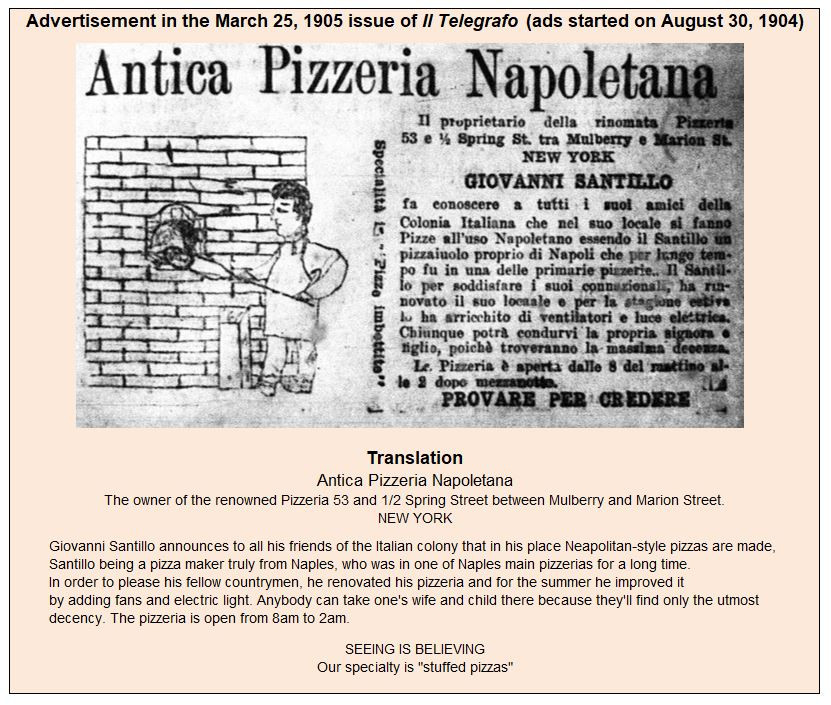 An advertisement from August 1904, unequivocally establishing Giovanni Santillo's "Antica Pizzeria Napoletana" at 53 Spring Street and detailing pizza offerings, predating Lombardi's presence.
An advertisement from August 1904, unequivocally establishing Giovanni Santillo's "Antica Pizzeria Napoletana" at 53 Spring Street and detailing pizza offerings, predating Lombardi's presence.
Expanding the Narrative: More Italian-American Advertising and Shifting Ownership
In 1907, another advertisement surfaced in “Piedigrotta alla Villa Vittorio Emanuele III,” a pamphlet edited by Luigi Pane, further enriching the history of 53 Spring Street. This ad reveals that during a trip to Naples by Giovanni Santillo and his wife Rosa between 1906 and 1907, the pizzeria was managed by Giuseppe Amabile, Rosa’s nephew, and Agostino Perera. Upon the Santillos’ return in October 1907, Giovanni Santillo resumed ownership, leading to a dispute with Perera who believed he had earned a share in the business. This disagreement resulted in Perera leaving and briefly opening “Nuova Pizzeria Port’Alba” across the street at 50 Spring Street in 1908, showcasing the competitive and dynamic nature of the early pizzeria scene.
 A 1907 advertisement from "Piedigrotta alla Villa Vittorio Emanuele III," revealing Giuseppe Amabile and Agostino Perera managing the pizzeria during Santillo's absence, highlighting the evolving ownership at 53 Spring Street.
A 1907 advertisement from "Piedigrotta alla Villa Vittorio Emanuele III," revealing Giuseppe Amabile and Agostino Perera managing the pizzeria during Santillo's absence, highlighting the evolving ownership at 53 Spring Street.
The Iconic Photograph and Lombardi’s Brief Initial Ownership
The famous photograph of Antonio Pero and Gennaro Lombardi in front of the pizzeria has long been cited as evidence of Lombardi’s early ownership, often mistakenly dated to 1905. However, detailed analysis places the photograph in the fall of 1908, shortly after the 21-year-old Gennaro Lombardi purchased the pizzeria from Giovanni Santillo, who then returned to Italy. This photo, while historically significant, actually documents Lombardi’s brief initial ownership, not the establishment’s founding.
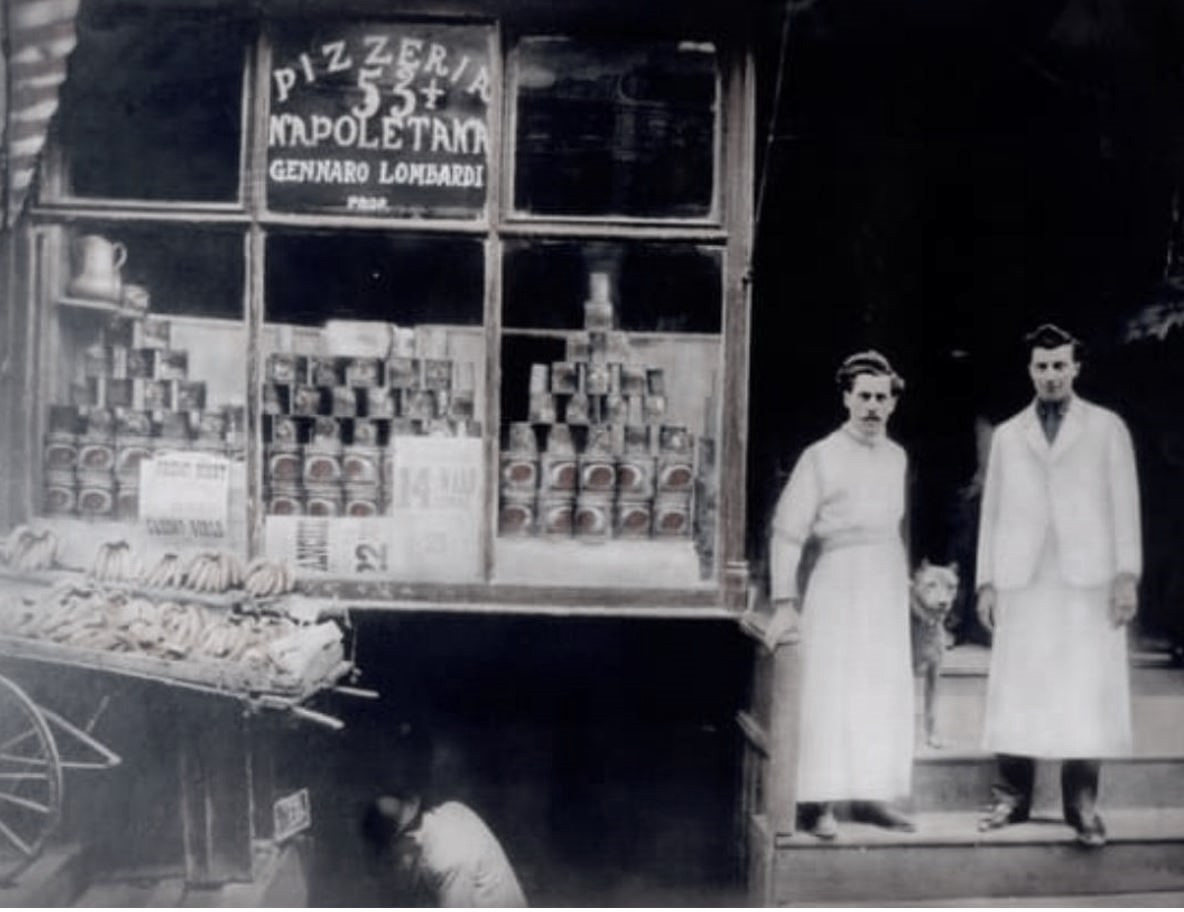 A colorized 1908 photograph of Antonio Pero and Gennaro Lombardi in front of the pizzeria at 53 Spring Street, accurately dated and contextualized to reflect Lombardi's purchase from Santillo, not the pizzeria's founding.
A colorized 1908 photograph of Antonio Pero and Gennaro Lombardi in front of the pizzeria at 53 Spring Street, accurately dated and contextualized to reflect Lombardi's purchase from Santillo, not the pizzeria's founding.
Lombardi’s ownership in 1908 was short-lived. By the spring of 1909, directory listings show Francesco D’Errico, a baker and relative of Lombardi’s by marriage, as the new owner of the restaurant. It appears Lombardi and D’Errico exchanged businesses, as Lombardi is later listed in the 1912 Trow’s Brooklyn Business Directory as the owner of D’Errico’s former bakery at 234 N. 5th Street in Williamsburg, Brooklyn.
World War I Records and Lombardi’s Return to Spring Street
World War I registration cards provide crucial evidence pinpointing when Gennaro Lombardi reacquired the Spring Street pizzeria from D’Errico. These records indicate the ownership transfer occurred between June 5, 1917, and September 12, 1918. While the 1918 City Directory still listed D’Errico as the owner, the ownership change likely happened around mid-1918.
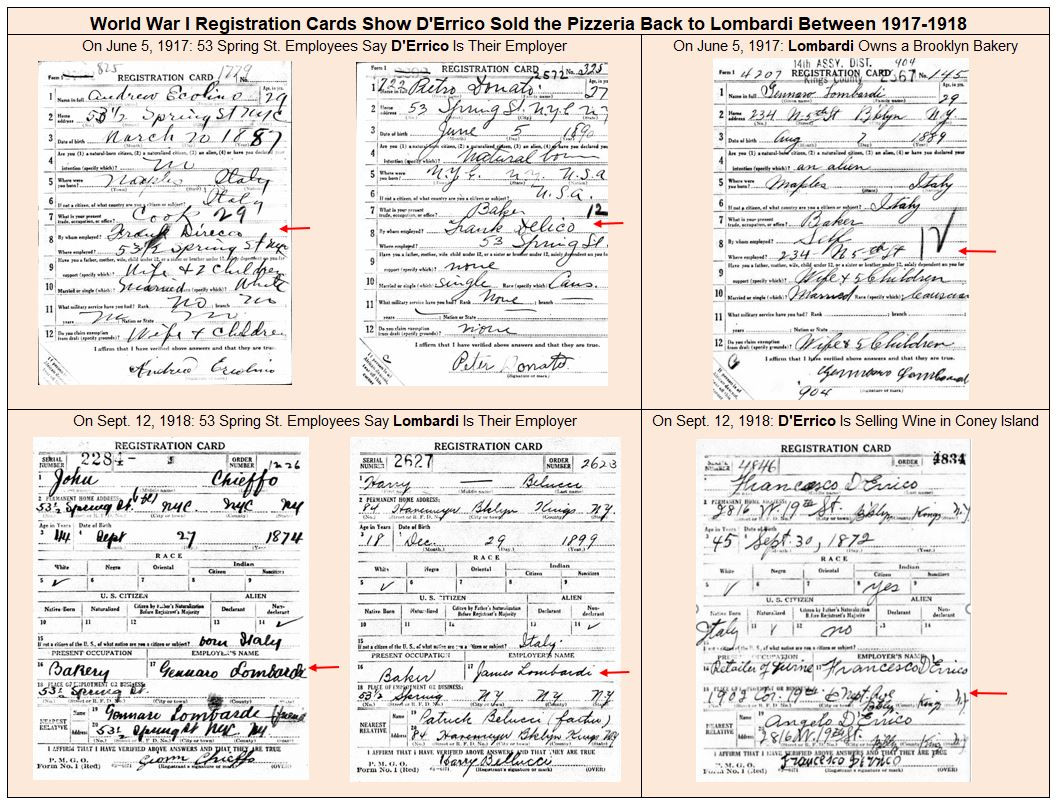 World War I registration cards documenting Francesco D'Errico and Gennaro Lombardi, providing evidence for the ownership transition of the pizzeria around 1918.
World War I registration cards documenting Francesco D'Errico and Gennaro Lombardi, providing evidence for the ownership transition of the pizzeria around 1918.
From this point in 1918 until his death in 1958, Gennaro Lombardi remained the owner of the pizzeria at 53 Spring Street. Initially called “Antica Pizzeria Napoletana,” it later became “Grande Pizzeria e Ristorante Napoletano,” and after the family purchased the building in 1939, “Lombardi’s Restaurant.”
Conclusion: A Revised History of Lombardi’s Pizza Spring Street
By synthesizing directory listings, Italian-American newspaper advertisements, and photographic and wartime records, a more accurate timeline of ownership for the Spring Street pizzeria emerges. This evidence firmly establishes that the claim of Gennaro Lombardi founding the first US pizzeria at 53 Spring Street in 1905 is historically inaccurate. The pizzeria’s origins likely trace back to Filippo Milone in the late 1890s, with Giovanni Santillo further solidifying its identity as “Antica Pizzeria Napoletana” by 1904. While Gennaro Lombardi’s enduring ownership from 1918 onwards cemented the pizzeria’s legendary status and namesake, the true story of 53 Spring Street is a richer tapestry woven with the contributions of multiple individuals who pioneered pizza making in America.


